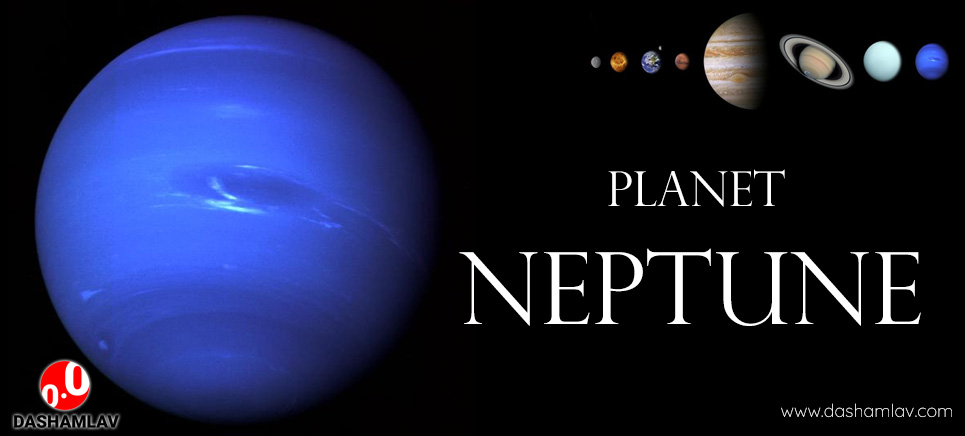Neptune is the eighth planet out from the Sun. It is the most distant planet in our solar system. For some time Pluto was considered to be the most distant planet — but now Pluto has been classified as a dwarf planet. Neptune draws its name from the Roman god of the sea. This is the windiest planet in the solar system. Let’s know a few interesting facts about planet Neptune.
1. Neptune was Found by using Mathematics!
Neptune is the only planet in our solar system that was discovered using mathematical prediction instead of empirical observation. French astronomer Alexis Bouvard, in 1821, predicted the presence of Neptune by studying the astronomical tables of Uranus. In 1845-46, Urbain Le Verrier, another French astronomer predicted the position of Neptune.
2. Strongest Winds in the Solar System
Winds of the speed up to 2,100 km/h keep blowing on Neptune. This is the highest wind speed on any planet in the solar system. Scientists find it difficult to explain how such an icy cold planet as Neptune can have such fast moving wind.
3. Neptune is Smallest among Gas Giants
We know that Jupiter, Saturn, Uranus and Neptune are known as gas giants because of their mainly gaseous composition and huge sizes. Neptune is the smallest among these planets with equatorial radius only of 24,764 km.
4. Neptune has Many Moons
It is a characteristic of gas giants to have numerous moons. So far 14 moons of Neptune have been discovered. Of these Triton is most interesting to scientists. Triton is a frozen satellite and while orbiting Neptune, it keeps spewing nitrogen ice from its surface. Neptune’s moons have been named after sea gods and nymphs in Greek mythology.

5. Only One Spacecraft has Ever Visited Neptune
Voyager 2 is the only spacecraft that visited Neptune. On 25 August 1989, Voyager 2 made its closest approach to the planet. Voyager’s approach to Neptune was telecast live in TV program called Neptune All Night.
6. Neptune has Rings
Like other gas giants, Neptune also has a ring system around it. So far, five main rings of Neptune have been observed. These rings are made of icy particles coated with silicates or carbon-based material.
7. Stormy Atmosphere
When Voyager 2 flew by, it recorded a Great Dark Spot in the southern hemisphere of Neptune. This spot was a massive storm with wind speed up to 1500 miles per hour. In images taken by Hubble telescope in 1994, the Great Dark Spot had disappeared and a new dark spot was visible.
8. Neptune’s Day is Short
Neptune spins on it’s axis quite rapidly and completes one rotation in just 16 hours. This short duration is probably because Neptune is not a solid planet.
9. And a Year is Very Long!
Neptune is about 2.8 billion miles (4.5 billion kilometers) away from the Sun. So, it takes about 165 Earth Years to complete an one obit around the Sun.
10. Neptune is Similar to Uranus
Just like Uranus, Neptune’s atmosphere is made of a thick fog of water, ammonia, and methane over a solid core that is similar to the size of Earth. Methane absorbs red portion from the visible light, making Neptune appear a fantastic shade of blue!
Statistics about Planet Neptune
| PROPERTY | VALUE |
|---|---|
| Radius of Neptune | 24,764 km |
| Surface area of Neptune | 7.6183 ×109 km2 (14.98 Earths) |
| Volume of Neptune | 6.254×1013 km3 (57.74 Earths) |
| Mass of Neptune | 1.02413×1026 kg (17.14 Earths) |
| Mean density | 16.38 g/cm³ |
| Perihelion (closest distance to Sun) | 29.81 AU (4.46 billion km) |
| Aphelion (farthest distance from Sun) | 30.33 AU (4.54 billion km) |
| Length of solar day (single rotation on its axis) | 16 h 6 min 36 s |
| Length of year (single revolution around the Sun) | 164.8 Earth years |
| Equatorial inclination to orbit (axial tilt) | 28.32° (to orbit) |
| Rotation speed at Equator | 2.68 km/s (9,650 km/h) |
| Surface gravity | 11.15 m/s2 |
| Escape velocity | 23.5 km/s |
| Natural satellite | So far, Uranus has 14 known natural satellites including the largest Triton |
| Composition of Neptune | Gases
Ices
|
Use the citation below to add this article to your bibliography
"Planet Neptune: Facts about the Most Distant Member of the Solar System." Dashamlav.com. Web. 12 June 2025. <https://dashamlav.com/planet-neptune-facts/>
Dashamlav.com, "Planet Neptune: Facts about the Most Distant Member of the Solar System." Accessed 12 June 2025. https://dashamlav.com/planet-neptune-facts/
"Planet Neptune: Facts about the Most Distant Member of the Solar System." (n.d.). Dashamlav.com. Retrieved 12 June 2025 from https://dashamlav.com/planet-neptune-facts/
